Ask the Developer – Super Mario Bros. Wonder
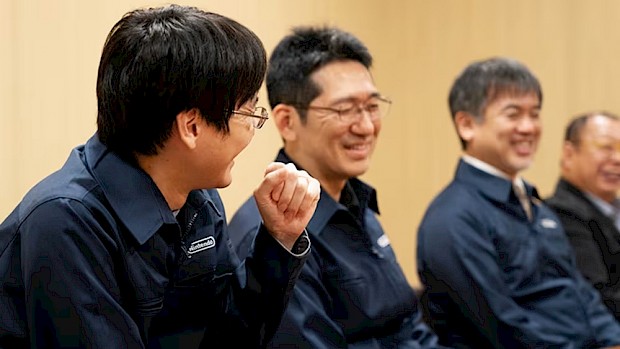
Posted 18 Oct 2023 at 20:41 by Joshua Phillips
Nintendo recently interviewed the developers of Super Mario Bros. Wonder about the creation of the title.
Many fascinating stories about the development of the game, working remotely, scrapped ideas, and more, are shared below!
Some of the interviewees have been a part of the Mario series for many years, including Koji Kondo, who created the music for the original Super Mario Bros. back on the NES.
You can see the participants of the interview, and their respective roles, in the image below.
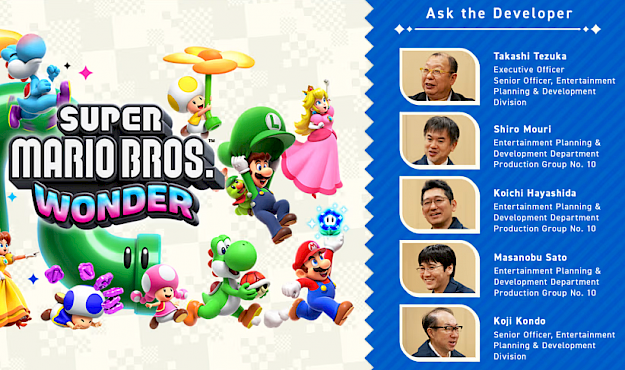
Mouri: Super Mario Bros. Wonder is the first entirely new installment in the side-scrolling Super Mario Bros. series in almost 11 years. Whenever you collect the new item, the Wonder Flower, the course and its gameplay transform dramatically, and a variety of "wonders" occur that would've been unimaginable in previous titles in the series.
While there have been other 2D Mario titles since New Super Mario Bros. U in 2012, such as New Super Mario Bros. U Deluxe and Super Mario Maker 1 & 2, it’s true that the last purely original title was the Wii U outing over a decade ago. Part of this is because of the nature of Super Mario Maker, and how it allowed gamers themselves to create levels of their own.
Nintendo themselves knew there was to be another original 2D Mario title at some point, but outsiders weren’t so sure, claiming the future would lie with Mario Maker. This sentiment is what helped drive the level of creativity going into this new title, as Takashi Tezuka explains:
Tezuka: I was already thinking about what kind of Mario game we should make next when we were developing Super Mario Maker 2. At the time, some journalists and players were saying that Super Mario Maker had eliminated the need for another 2D Mario game. But I kept saying that the next Mario game would be completely different from Super Mario Maker, so there was no need to worry.
In hindsight, those kinds of sentiments may have been what motivated me to come up with ideas for this game.
Hayashida: Players have created so many different courses in Super Mario Maker that I was worried about whether we could do anything new that would go beyond that. But apparently, Tezuka-san thought it would be fine. (Laughs)
Hayashida: Yes, I remember Mouri-san saying during the early stages of development that we shouldn't use the same game engine as in the New Super Mario Bros. series but rather create a new game engine that would serve as a foundation for future 2D Mario games.
Thankfully, Tezuka-san also told us to prioritize content over schedule.
Tezuka: We wanted to create a game with much more to offer than ever before, so this time, we didn't set a fixed time period for development, which is usually decided before we kick off.
To create something truly enjoyable, we decided to take our time and dedicate ample budget for development without having to worry about the production schedule. So at first, we only had a small group working on the development.
Shiro Mouri laments how, in the original Super Mario Bros., there was a sense of wonder when unexpected things happened, such as hitting a ‘?’ Block and seeing a mushroom pop out.
Our own personal experience of this was when we were victim to a poison mushroom in our younger years on Super Mario All-Stars, a shocking surprise after years of being conditioned to trust the fungus.
It seems the core aim of Super Mario Bros. Wonder was to have that sense of surprise and awe once more.
Mouri: The reality of coming up with something that would elicit a sense of wonder from a modern audience was quite difficult.
Previous 2D Mario games featured variations of challenges that would scale up in difficulty as players progressed. This time, though, we decided not to focus on creating such variations but rather on offering a large number of surprises that we thought would be fun.
Frankly speaking, I wanted to include at least one element in each course that would surprise or delight players. So I decided to consult Hayashida-san who had been involved in the development of 3D Mario games and ask him how he included such elements in Super Mario Odyssey.
Hayashida: 3D Mario games are sometimes described by the media and players as a "toy box of ideas," so I decided to apply some of the ideas we used to create 3D Mario games to a 2D Mario game. With these things in mind, we decided to have an idea-sharing session.
Everyone from programmers to designers and sound designers joined in and wrote down gameplay ideas on sticky notes, which could be unrelated to their field of expertise, and we made prototypes on the spot. There were just so many ideas. Before this interview, I counted the number of sticky notes we had, and there were over 2,000! (Laughs)
In development there was talk about how warp pipes in the original Super Mario Bros. games were fun and exciting. Pipes that warped and changed shape were one concept for Wonder, as well as players warping to another world via an item, as pictured below.
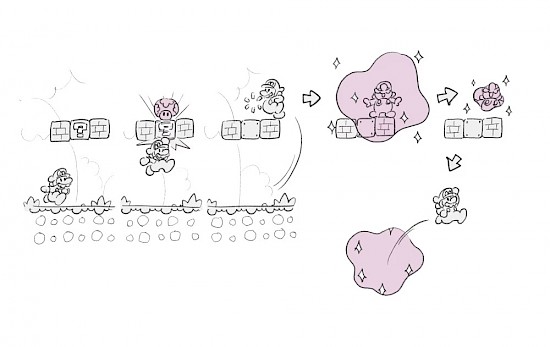
While they wanted to go all out with new ideas, they also wanted established standards of Mario games to apply. How could they have the best of both worlds? The answer seems to lie in the “Wonder effect”, as Sato describes below:
Sato: There are some deviations from the rules of the Mario world we've seen in the past. For example, we all know pipes are solid, so we're confident that shells we kick will bounce back if they hit one. We also know that we can safely jump on pipes. Keeping this feeling of trust in a side-scrolling 2D Mario game was crucial.
But we didn't want to give up on an idea that people had spent a lot of energy on, just because it wouldn't fit in and look right. So we took great pains to create a world that could incorporate this idea. We decided to incorporate this major transformation as a mysterious phenomenon called the "Wonder effect" and use unconventional visuals.
Hayashida: From then on, we held Wonder prototype meetings, where we selected ideas from the more-than-2,000 sticky notes and other materials produced in the idea-sharing session and created prototypes that matched the world of Wonder. Various ideas were incorporated into the game as we went along.
So while the visuals are clearly distinct when the Wonder effect is active, the development team also felt the music had to match the mysterious new vibes too.
Kondo: To make the sound of activating the Wonder effects more unconventional, we used a lot of up-tempo background music. We also made the environmental sounds and sound effects more dynamic to give a sense of complete change from the regular course.
The course background music has also been redesigned. Instead of the analog synthesizer-like sounds used in New Super Mario Bros., we've incorporated the sounds of musical instruments and digital synthesizers to introduce a musical genre that has never been heard in Mario history.
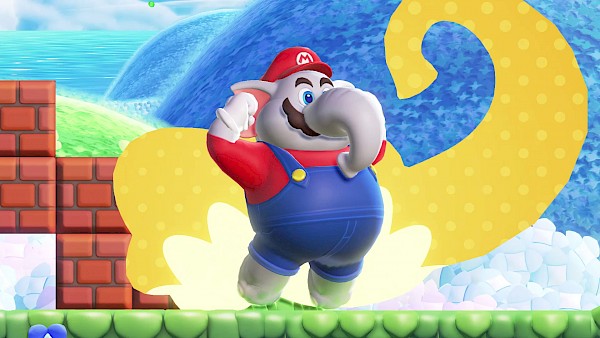
The development team were keen to pay close attention to animations in this new title, but this wasn’t a direct result of the recently released Super Mario Bros. Movie.
Sato: We're often asked about the film's influence on the game, but we didn't hear anything about the film's content during development. I think Tezuka-san and Kondo-san were the only members here who knew the details.
The looming movie did have some influence over those in the know, though, as Tezuka explains:
Tezuka: During development, we didn't know when the movie would be released, but we were sure some people would play the game because they watched the movie. This is why we were conscious of creating a game that wouldn't disappoint them. So for this game, we dedicated ample budget and time to create the characters with even more care and attention and in greater detail.
Hayashida: Also, with Nintendo Switch's technology, we were able to make movements and facial expressions more dynamic than before. The number of joints has also increased considerably. The more joints there are, the broader the range of motion and the greater the variety of movements that can be expressed.
The extra power of the Nintendo Switch, compared to previous consoles, gave them much more freedom in creating expressive characters. But there were some complications.
Sato: Both joints and animations have more than doubled in number since the previous title. Facial expressions that are difficult to express using joints were created by replacing the models with new ones.
In this game, we revisited Mario's iconic poses from the days of pixel graphics. We took a look at each of them, including a jumping motion with arms extended and a sudden stop after running. As a result, we believe we've been able to create characters that leave a strong impression.
However, while it was good that the characters were more expressive, another challenge surfaced when we tried to turn their faces toward players to show their expressions.
It's a well-known story within the company that Miyamoto-san said designing Mario's nose to be big back in the day of the very first pixelated Mario made it easier to see which direction Mario was facing. But if we set Mario's nose to face the direction of travel, like we used to, with a modern 3D model, you wouldn't be able to see his facial expressions.
On the other hand, if we turned Mario's face toward players so they could see his facial expressions, it would be difficult to tell which direction he's moving. Therefore, we had to find the right balance to make it easy for players to see both the character's expressions and where they're headed.
Sato provided a peek behind the curtain, and showed a perspective of Mario you wouldn’t usually see in game:
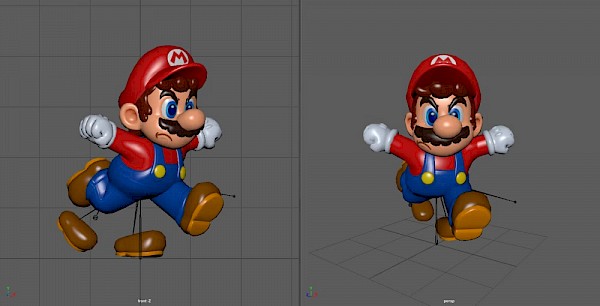
Sato: If you look at the picture on the right, you'll see that Mario's face is distorted when seen from the direction he's traveling toward. However, if you look at the picture on the left, you can see how Mario appears on-screen.
During gameplay, players can see both the direction Mario is heading and his facial expressions. In fact, we've made these kinds of adjustments not only to the facial expressions but to the entire body.
It’s not just Mario and friends that have had an animation overhaul though, as the enemies also express themselves in ways not seen previously!
Sato: Even before development on Super Mario Bros. Wonder was confirmed, we were looking to broaden the range of expressions that enemies had. It wasn't possible to completely change the behavior of the well-known enemies in this game without altering the gameplay, but we wanted to be able to demonstrate to fans that we'd made some adjustments to them.
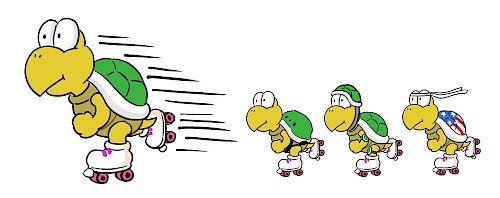
Sato: One of the designers came up with the idea of making the Koopa Troopas roll around on roller skates. (Laughs)
Not being able to work at an established workplace for roughly two years during 2020 - 2021 and beyond had a slight impact on the development of this game, especially at the height of the imposed restrictions when people were tasked with working from home. This wasn’t all bad news though, as it created some unique ways of working that hadn’t happened before at Nintendo.
Tezuka: Since meetings now took place online, we no longer had to limit the number of participants [in team-wide discussions] due to limited space in meeting rooms, so we made it a rule to open meetings to the entire development team so that anyone could join at any time.
Hayashida: We let members join online meetings without turning on their cameras so that they could just listen in while multitasking. I'm glad we were able to share information widely across the team in this way.
Of course, there were difficulties developing a game in an unfamiliar, work-from-home environment, but we were able to take advantage of the situation and work on new approaches.
Some elements of previous 3D Mario games also helped shape this title. For example, Super Mario Sunshine is partly responsible for Elephant Mario, as Elephant Mario was created after ideas for water-based elements were proposed in Super Mario Bros. Wonder.
Hayashida: With the ability to spray water, you can make withered flowers bloom that in turn generate a variety of things. So I thought this ability would enable us to create new secrets and wonders.
Also, I was involved in the development of Super Mario Sunshine alongside Mouri-san. I remember spraying quite a bit of water in that game. (Laughs)
It was great to work with Mouri-san once again after 21 years to create another Mario game where we can spray water. (Laughs)
Super Mario Bros. Wonder is less linear than previous 2D Mario games, taking inspiration from 3D Mario titles that allow you to collect different moons or stars (depending on the game) in whichever order you wish.
So if you’re stuck on one mission in a 3D Mario game, you can try a different one instead, and still reach the end of the game. This was previously not an option in the 2D titles, and some of Nintendo’s own developers found it a problem when playing them.
Tezuka: Compared to 3D Mario games, 2D Mario games may seem to have less visual variation and be more challenging to complete. But then we made a small discovery when developing the smartphone app Super Mario Run. One of the development team members who wasn't that skilled at Mario platformers told us, “I want to see more of the game, but I can't progress because I'm not that good at this type of game.”
Sato: I heard that, in the course where you need to jump on mushroom platforms consecutively at the start, this person kept falling into the pit.
Tezuka: We didn’t think it was that challenging, so we hadn't realized you'd feel discouraged from continuing the game if it felt too difficult. So we started to think about what we could do to make players want to advance. Then we thought, maybe there isn't enough freedom. For example, I feel that Super Mario Odyssey is designed so that all players can reach the ending, no matter how they progress through the game.
I felt that 2D Mario games often had the reputation of being unforgiving. Compared to 3D Mario games, just one mistimed action can lead to a bigger mistake, since you have fewer options in terms of movement. In this game, we've changed that. We've designed it so that players can conquer the game with their ideas and use their heads, not just their skills, to progress.
Hayashida: With all that in mind, we felt that a 2D Mario game adapted to the times would be one that you could complete your way. For example, up until now, 2D Mario games have been in a format where players complete each course in sequence. But in this title, players who want a challenge can start with a difficult course, and beginners can start with an easier one. Each course has its difficulty indicated too.
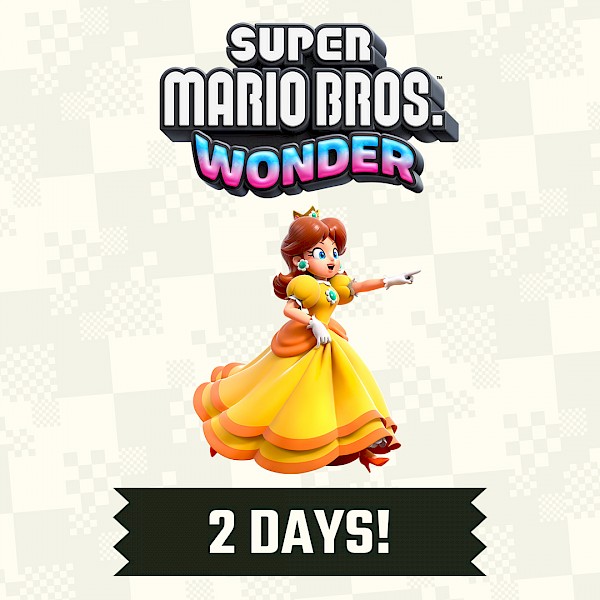
Daisy is counting down the days! Via the Nintendo UK X account (previously Twitter).
2D Mario games aren’t just a single player affair, and in-fact, since New Super Mario Bros. Wii onwards, multiplayer has been as big a part of the experience as the single player adventure. This also applies to Wonder, which will have online and offline options.
Mouri: From the initial concept, we wanted to develop a Mario game that's also fun to play online. However, while playing online with people from around the world can be fun, we believe there are also some challenges. For example, in competitive games, more-skilled players can have multiple wins and feel satisfied, while newcomers give up early because they keep losing.
In co-op games, those who aren't skilled at games can drag the team down. Also, there's a very small percentage of players who behave inappropriately and cause trouble. I’ve always wanted to create fun online gameplay, free from those sorts of worries. That's how we landed on the key phrase “a casual connection.”
Basically, you can enjoy the game as if you're playing solo. You don’t have to be on standby while you’re matched up with other players; matching takes place automatically behind the scenes during single player, so there’s no waiting around.
If someone in the world is playing the same course as you at the same time, you can connect and play online together. And so, we came up with ideas to form this casual connection with players worldwide.
We call other online players "live player shadows," and if you greet them, they might greet you back, give you an extra item if they have one, or even help you when you make a mistake. But they can't attack or disturb you. We wanted to create gameplay where only things that benefit the player can happen, and that resulted in the current design.
Online play is also what caused Super Mario Bros. Wonder to have a bigger cast than previous 2D Mario outings.
Mouri: Because you can connect with players around the world, we thought it’d be good to have lots of characters to choose from. This is one of the reasons why we decided to have the 12-character lineup from the initial stage of development.
A new trailer showcasing some of the Wonders that await!
Finally, one of the wildest ideas for Super Mario Bros. Wonder, the idea of a live-commentary, ended up being implemented as the talking flowers. Proof that no matter how crazy an idea, if it’s a good one, it can be included in some form, no matter how impossible it may initially sound.
Mouri: Tezuka-san also once asked, “Can’t we have live commentary?” I had absolutely no clue what he meant. (Laughs) But I interpreted it as a desire for a new experience, even if it’s not necessarily in the form of live commentary.
Hayashida: We actually spent about six months seriously developing live commentary. We tried adding voices to match the player's actions. Even though we'd added various voices, questions like, “Who’s doing this commentary?” started to pop up amongst the team. Something about it just didn’t feel right. (Laughs)
Mouri: Even the team was evenly split between those in favor and those against. (Laughs) The default voice was very generic, like a newscaster, but you had the option to switch it to a Tsundere commentary.
(Tsundere is an adjective term in Japanese that is used to describe a personality or a person who usually has a cold and harsh attitude but on the other hand shows a glimpse of affection.)
Mouri: In fact, according to our play test records, quite a few people were switching to the Tsundere commentary. (Laughs)
Everyone: (Laughs)
Tezuka: But if we were to do this commentary feature seriously, just the process of creating voice variations alone would've involved a tremendous amount of work. So, unfortunately, we had to let it go.
Still, it would've been a shame to shut down the whole experiment. So we brought in an additional team member to dedicate themselves to this feature full-time.
Mouri: Around the same time, there was a discussion about setting the game in the Flower Kingdom, and we were able to incorporate the idea of live commentary in the form of Talking Flowers that would match the game's world. It's a version of live commentary that fits the world of Mario.
Hayashida: It's nice that you're never lonely when the Talking Flowers are there. If you were all alone in a course, it might feel like it was you against the world, but the Talking Flowers speak to you at just the right time.
Sato: They've got some funny lines like, “Make sure you're getting your veggies!” as a parent might say. (Laughs) I think it's a fun experience for those watching the player too.
Tezuka: We thought the gameplay might be more enjoyable if the Talking Flowers speak to you and you can resonate with what they're saying. Of course, there's an option to turn off the chatter, but we hope as many people as possible will give it a listen.
Mouri: And by making them something that exists in the course, we were able to create a new type of Mario gameplay. For example, searching for a hidden Talking Flower or catching a glimpse of one above you and working out how you can reach it.
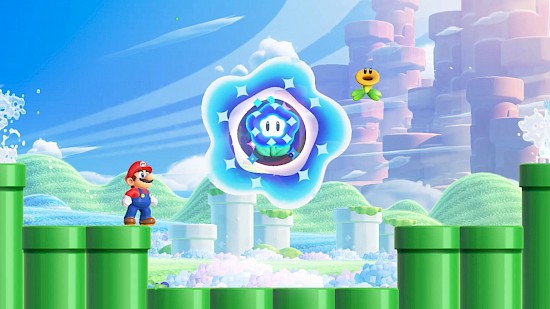
Super Mario Bros. Wonder releases in just 2 days, on Friday November 20th!
We hope this piece has given you a sense of wonder and excitement for Mario’s upcoming adventure! This is a condensed article, featuring all of the juiciest bits and pieces from an extensive 4-part interview on Nintendo’s official site.
You can read each part in full on Nintendo’s official site here:





















